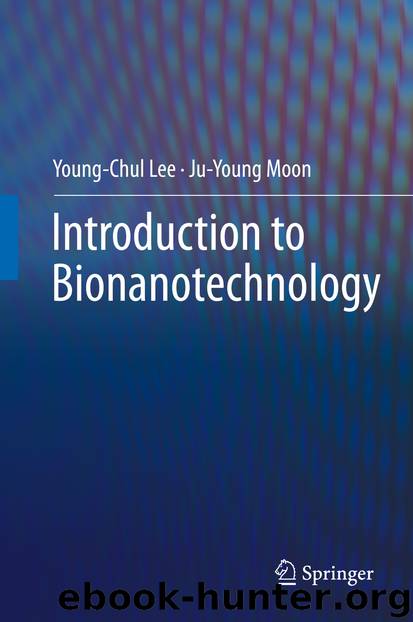Introduction to Bionanotechnology by Young-Chul Lee & Ju-Young Moon

Author:Young-Chul Lee & Ju-Young Moon
Language: eng
Format: epub
ISBN: 9789811512933
Publisher: Springer Singapore
As mentioned above, the electron density map, which allows us to observe the density of electrons in the structure of the crystal, is the result obtained when using X-ray crystallography analysis. A very influential factor to this map is the quality of the analytical samples, more specifically, the quality of the analytical crystals. It will affect the resolution of the map or the distance between the electron density points on the map. Therefore, high crystal quality will result in excellent resolution. Then the components of the crystal - or molecule - with a distance less than 1 Angstrom unit Å, will also be analyzed and displayed in a more straightforward and more precise way. For example, with low resolution 3.0Å, we will need more analysis and covalent to explain and determine the distance between points when they are less resolution. In resolution 1.5Å, single atoms are displayed more easily [6]. Once we have a map with a high resolution, this map-based molecular structure will produce a high-quality atomic structure by interpreting them according to the atomic model. The positions in the electron density map are better when we use the atomic structure created from it. These positions can be defined as smaller than 1 Angstrom Å. In the lower resolution, we need to analyze more before using the final result. We have yet another limitation of the data obtained, that is, for the surface area and the unstable area of the structure, the observed electron density maps are not clearly expressed, resulting in the structure corresponding only to the primary data, at the basic and the most accurate level possible. As we all know, atoms have their movements and depend heavily on temperature factors. It can be used to express the “chaotic” level of atoms. Moreover, so the temperature factor of the position of the atom in the structure model will provide good signs to evaluate each position of the atom. This temperature value covers the width of the Gaussian distribution curve of the model atom around the center of the atom. When this value is high (around 30), it shows the high degree of instability of the position of the analyzed atoms, the rhyme is further processed, and vice versa, this value is low (about 10), the location in the map is expressed [1].
Therefore, in order to implement this technique, we need to invest in equipping a qualified laboratory and equipment to carry out “raising” the crystal, collecting and processing X-ray data. There are many references available to this area that we can use for better understanding [3]. Another limitation of the X-ray crystallography method is the crystal requirement of the analytical structure [7]. The general structure may be the same when analyzing protein samples with different lattice structures. Besides, this requirement for many dissolved proteins cannot be met. Biological molecules are “forced” in a crystalline order, so the resulting structure is only a model that corresponds relatively well to biological molecules in nature. Therefore, the crystal structure needs
Download
This site does not store any files on its server. We only index and link to content provided by other sites. Please contact the content providers to delete copyright contents if any and email us, we'll remove relevant links or contents immediately.
| Automotive | Engineering |
| Transportation |
Whiskies Galore by Ian Buxton(41879)
Introduction to Aircraft Design (Cambridge Aerospace Series) by John P. Fielding(33064)
Small Unmanned Fixed-wing Aircraft Design by Andrew J. Keane Andras Sobester James P. Scanlan & András Sóbester & James P. Scanlan(32743)
Craft Beer for the Homebrewer by Michael Agnew(18140)
Turbulence by E. J. Noyes(7936)
The Complete Stick Figure Physics Tutorials by Allen Sarah(7307)
Kaplan MCAT General Chemistry Review by Kaplan(6867)
The Thirst by Nesbo Jo(6828)
Bad Blood by John Carreyrou(6552)
Modelling of Convective Heat and Mass Transfer in Rotating Flows by Igor V. Shevchuk(6391)
Learning SQL by Alan Beaulieu(6211)
Weapons of Math Destruction by Cathy O'Neil(6146)
Man-made Catastrophes and Risk Information Concealment by Dmitry Chernov & Didier Sornette(5921)
Digital Minimalism by Cal Newport;(5664)
Life 3.0: Being Human in the Age of Artificial Intelligence by Tegmark Max(5474)
iGen by Jean M. Twenge(5366)
Secrets of Antigravity Propulsion: Tesla, UFOs, and Classified Aerospace Technology by Ph.D. Paul A. Laviolette(5309)
Design of Trajectory Optimization Approach for Space Maneuver Vehicle Skip Entry Problems by Runqi Chai & Al Savvaris & Antonios Tsourdos & Senchun Chai(5011)
Pale Blue Dot by Carl Sagan(4912)
